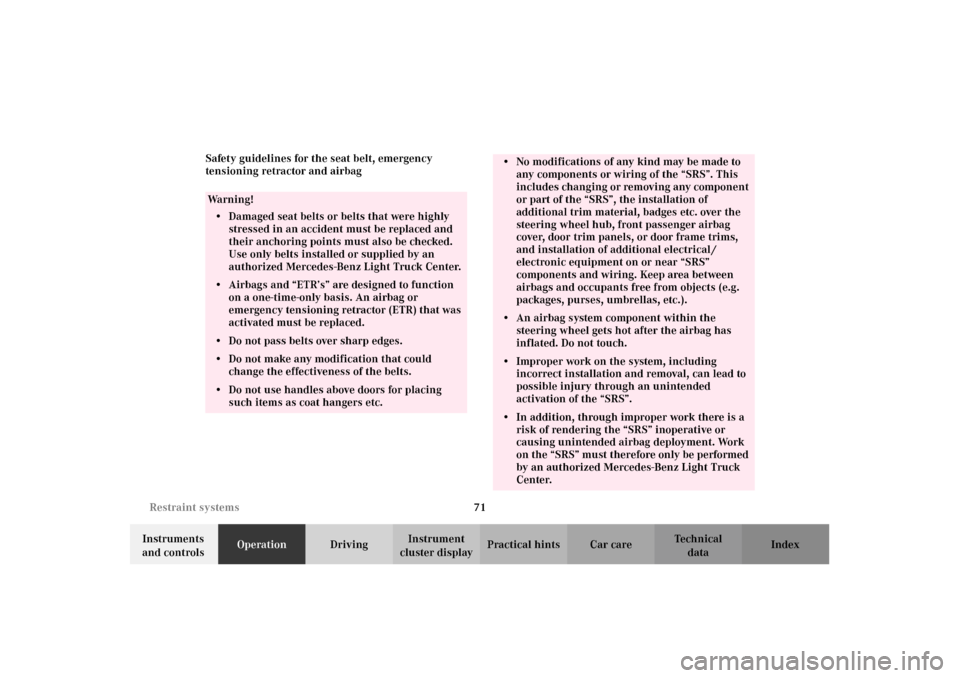2002 MERCEDES-BENZ G500 instrument panel
[x] Cancel search: instrument panelPage 4 of 385

1 Contents
IntroductionProduct information .......................... 7
Roadside assistance ......................... 10
Where to find it ................................ 14
Reporting Safety Defects ................ 16Instruments and controlsInstruments and controls ............... 18
Center console .............................. 20
Door control panel ....................... 22
Overhead control panel ............... 23OperationVehicle keys ...................................... 26
Start lock-out .................................... 28
General notes on the
central locking system ............... 28
Central locking system ................... 29
Radio frequency and
infrared remote control ............... 29
Locking and unlocking ................ 31Choosing global or
selective mode on
remote control ...............................31
Opening and closing windows
and sliding / pop-up roof
from outside ................................. 32
Panic button ................................. 33
Mechanical keys .......................... 33
Doors ................................................. 34
Locking and unlocking
driver’s door manually ............... 36
Tailgate .............................................. 37
Locking and unlocking
the tailgate manually .................. 38
Locking the tailgate separately . 39
Central locking switch .................... 40
Automatic central locking ............... 41
Emergency unlocking in
case of accident ........................... 41
Antitheft alarm system ................... 42
Tow-away alarm ............................... 43
Easy-entry/exit feature .................. 44
Front seat adjustment ..................... 45Synchronizing head restraints
and seat adjustment fore, aft ..... 47
Removal and installation of
front seat head restraints .......... 51
Seat heater, front ............................. 52
Seat heater, rear ............................... 54
Seat belts and
integrated restraint system ....... 56
Seat belts ........................................... 56
Seat belt nonusage
warning system ............................ 57
BabySmart
TM airbag
deactivation system .................... 63
Self-test BabySmart
TM without
special child seat installed ........ 63
Supplemental restraint system
(SRS) ............................................. 64
Emergency tensioning retractor
(ETR) ............................................. 65
Airbags .............................................. 66
Safety guidelines for the
seat belt, emergency
tensioning retractor and
airbag ............................................ 71
J_G463.book Seite 1 Mittwoch, 19. September 2001 8:06 08
Page 20 of 385

17 Contents - Instruments and controls
Te ch n i c a l
data Instruments
and controlsOperation DrivingInstrument
cluster displayPractical hints Car care Index
Instruments and controlsInstruments and controls ............... 18
Center console .............................. 20
Door control panel ....................... 22
Overhead control panel ............... 23
J_G463.book Seite 17 Mittwoch, 19. September 2001 8:06 08
Page 25 of 385

22 Instruments and controls
Te ch n i c a l
data Instruments
and controlsOperation DrivingInstrument
cluster displayPractical hints Car care Index
Door control panel1Door handle, pull to open, see page 34
2Memory function, for storing seat, steering wheel
and exterior rear view mirrors, see page 48
3Front seat adjustment switch, see page 45
4Steering wheel adjustment switch, see page 78
5Power window switches, see page 151
1
2
3
4
5
J_G463.book Seite 22 Mittwoch, 19. September 2001 8:06 08
Page 26 of 385

23 Instruments and controls
Te ch n i c a l
data Instruments
and controlsOperation DrivingInstrument
cluster displayPractical hints Car care Index Overhead control panel1Interior lighting, see page 156
2Tele Aid (emergency call system), see page 192
3Sliding /pop-up roof, see page 154
4Hands-free microphone for Tele Aid, telephone and
voice recognition system
5Rear view mirror, see page 79
6Garage door opener, see page 185
J_G463.book Seite 23 Mittwoch, 19. September 2001 8:06 08
Page 64 of 385

61 Restraint systems
Te ch n i c a l
data Instruments
and controlsOperationDrivingInstrument
cluster displayPractical hints Car care Index
• Never wear the shoulder belt under your arm,
against your neck or off your shoulder. In a
crash, your body would move too far forward.
That would increase the chance of head and
neck injuries. The belt would also apply too
much force to the ribs or abdomen, which
could severely injure internal organs such as
your liver or spleen.• Never wear belts over rigid or breakable
objects in or on your clothing, such as
eyeglasses, pens, keys etc., as these might
cause injuries.• Position the lap belt as low as possible on your
hips and not across the abdomen. If the belt is
positioned across your abdomen, it could cause
serious injuries in a crash.
• Each seat belt should never be used for more
than one person at a time. Do not fasten a seat
belt around a person and another person or
other objects.• Belts should not be worn twisted. In a crash,
you wouldn’t have the full width of the belt to
manage impact forces. The twisted belt against
your body could cause injuries.• Pregnant women should also use a lap-
shoulder belt. The lap belt portion should be
positioned as low as possible on the hips to
avoid any possible pressure on the abdomen.• Never place your feet on the instrument panel
or on the seat. Always keep both feet on the
floor in front of the seat.
J_G463.book Seite 61 Mittwoch, 19. September 2001 8:06 08
Page 74 of 385

71 Restraint systems
Te ch n i c a l
data Instruments
and controlsOperationDrivingInstrument
cluster displayPractical hints Car care Index Safety guidelines for the seat belt, emergency
tensioning retractor and airbag
Wa r n i n g !
• Damaged seat belts or belts that were highly
stressed in an accident must be replaced and
their anchoring points must also be checked.
Use only belts installed or supplied by an
authorized Mercedes-Benz Light Truck Center.• Airbags and “ETR’s” are designed to function
on a one-time-only basis. An airbag or
emergency tensioning retractor (ETR) that was
activated must be replaced.• Do not pass belts over sharp edges.• Do not make any modification that could
change the effectiveness of the belts.• Do not use handles above doors for placing
such items as coat hangers etc.
• No modifications of any kind may be made to
any components or wiring of the “SRS”. This
includes changing or removing any component
or part of the “SRS”, the installation of
additional trim material, badges etc. over the
steering wheel hub, front passenger airbag
cover, door trim panels, or door frame trims,
and installation of additional electrical /
electronic equipment on or near “SRS”
components and wiring. Keep area between
airbags and occupants free from objects (e.g.
packages, purses, umbrellas, etc.).•An airbag system component within the
steering wheel gets hot after the airbag has
inflated. Do not touch.• Improper work on the system, including
incorrect installation and removal, can lead to
possible injury through an unintended
activation of the “SRS”.• In addition, through improper work there is a
risk of rendering the “SRS” inoperative or
causing unintended airbag deployment. Work
on the “SRS” must therefore only be performed
by an authorized Mercedes-Benz Light Truck
Center.
J_G463.book Seite 71 Mittwoch, 19. September 2001 8:06 08
Page 132 of 385

129 Exterior lamp switch
Te ch n i c a l
data Instruments
and controlsOperationDrivingInstrument
cluster displayPractical hints Car care Index Exterior lamp switch
MOff
UAutomatic headlamp mode, see below.
CPar k ing lamps (als o s id e m ar ker lamps , taillamps ,
licence plate lamps, instrument panel lamps)
Canada only: When the engine is running, the low
beam is additionally switched on.BParking lamps plus low beam or high beam
headlamps (combination switch pushed forward).
ˆStanding lamps, right (turn left one stop)
‚Standing lamps, left (turn left two stops)
‡Front fog lamps (pull out one stop) with parking
lamps and/or low beam headlamps on. Green
indicator in lamp switch comes on.
†Rear fog lamp (pull out to second detent) in
addition to the front fog lamps. Yellow indicator in
lamp switch comes on.
Note:
With the electronic key removed and the driver’s door
open, a warning sounds if the vehicle’s exterior lamps
(except standing lamps) are not switched off.
Fog lamps will operate with the parking lamps and / or
the low beam headlamps on. Fog lamps should only be
used in conjunction with low beam headlamps. Consult
your State or Province Motor Vehicle Regulations
regarding allowable lamp operation.
Fog lamps are automatically switched off when the
exterior lamp switch is turned to position M or U.
2563
J_G463.book Seite 129 Mittwoch, 19. September 2001 8:06 08
Page 146 of 385

143 Climate control
Te ch n i c a l
data Instruments
and controlsOperationDrivingInstrument
cluster displayPractical hints Car care Index Climate control
The system is always at operational readiness, except
when manually switched off, see page 147.
The climate control only operates with the engine
running.
The air conditioning will not engage (no cooling) if the
economy mode AC
OFF
is selected, see page 147.
The temperature selector should be left at the desired
temperature setting. The temperature selected is
reached as quickly as possible.
The system will not heat or cool any quicker by setting a
higher or lower temperature.
The desired interior temperature can be selected
separately for the left and right side of the passenger
compartment. Adjust the temperature settings in small
increments.
The climate control removes considerable moisture from
the air during operation in the cooling mode. It is
normal for water to drip on the ground through ducts in
the underbody.Notes:
Do not obstruct the air f low by placing objects on the air
flow-through exhaust slots on the back left and right
trim panel in the rear cargo compartment.
Also keep the air intake grill in front of the windshield
free of snow and debris.
The air conditioner switches itself off for its own
protection if refrigerant is lost. No cooling will then take
place. Economy mode AC
OFF
cannot be switched off.
Have the air conditioner checked by a Mercedes-Benz
Light Truck Center should this happen.
If the vehicle interior has been heated by direct sunlight
and is very hot, ventilate the interior (open door or
windows for a short period) before driving off.
Dust filter
Nearly all dust particles and pollen are filtered out
before outside air enters the passenger compartment
through the air distribution system.
J_G463.book Seite 143 Mittwoch, 19. September 2001 8:06 08